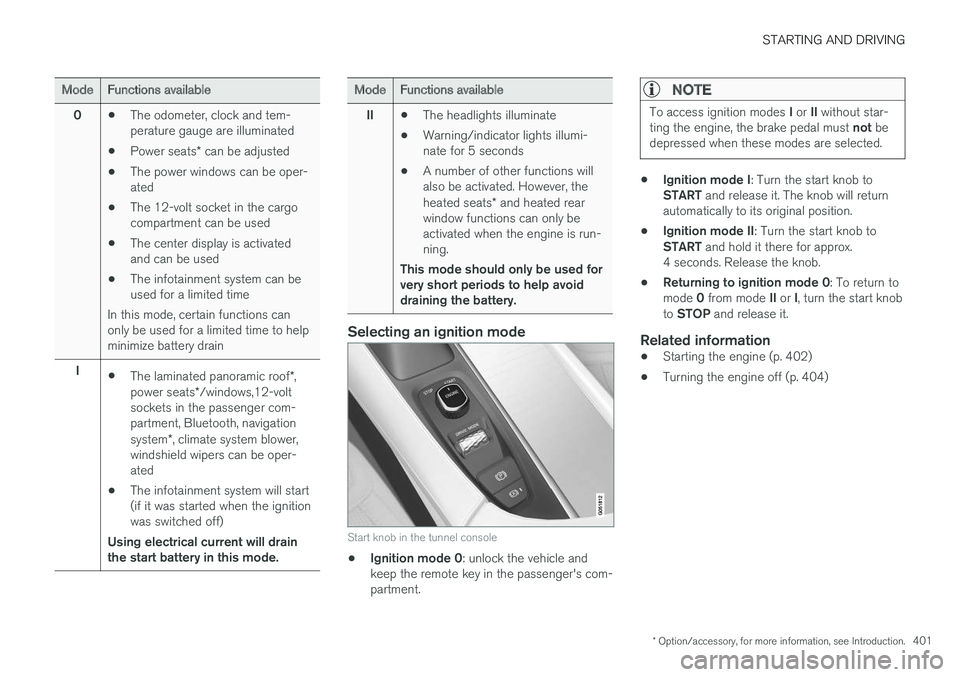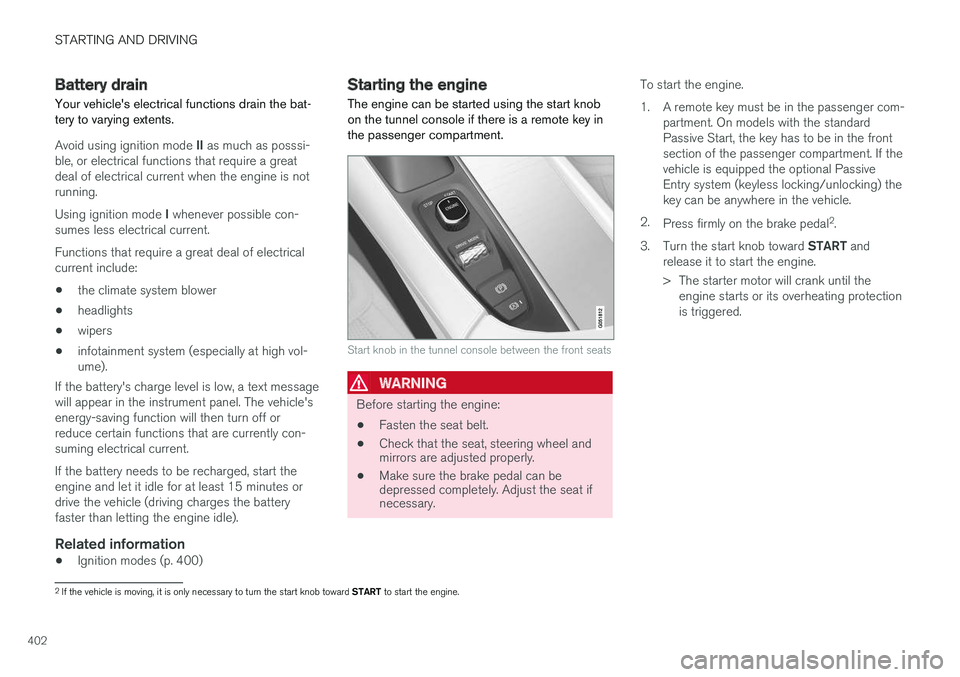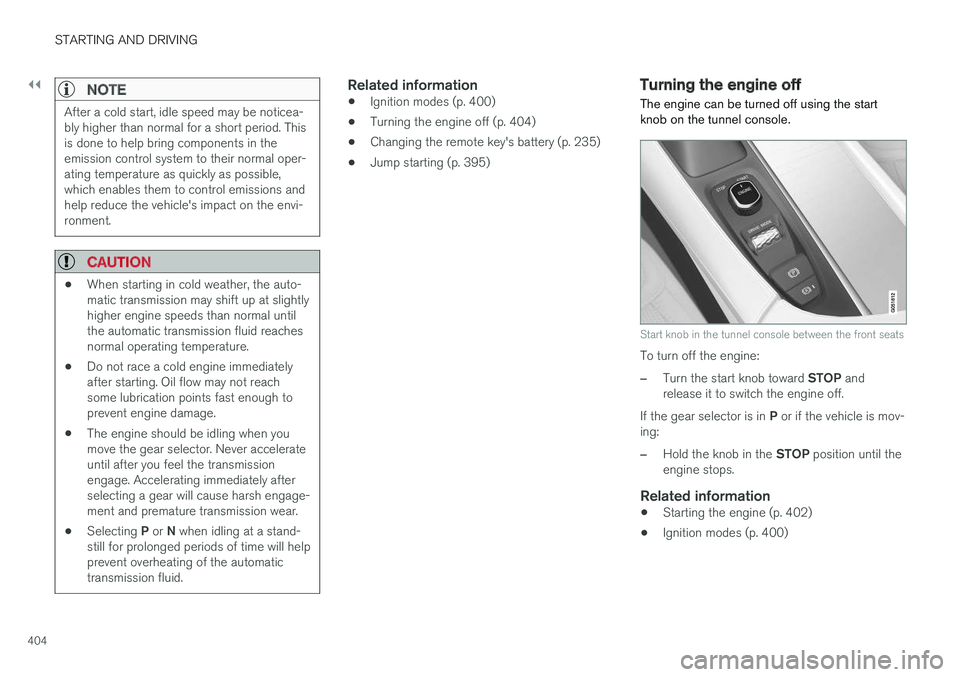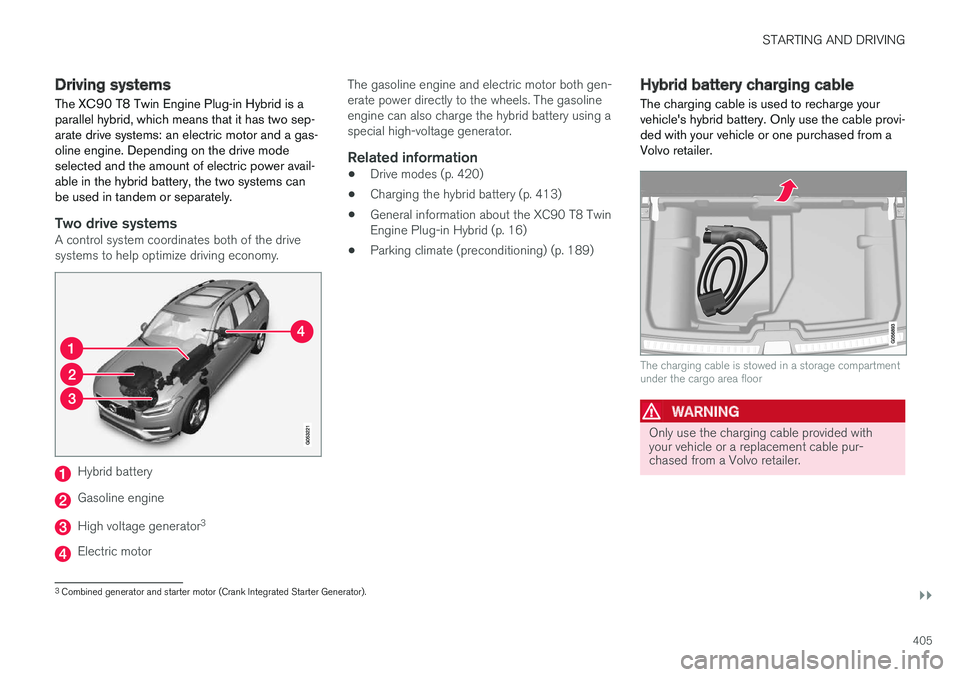engine VOLVO XC90 TWIN ENGINE HYBRID 2017 Owners Manual
[x] Cancel search | Manufacturer: VOLVO, Model Year: 2017, Model line: XC90 TWIN ENGINE HYBRID, Model: VOLVO XC90 TWIN ENGINE HYBRID 2017Pages: 584, PDF Size: 14.2 MB
Page 400 of 584

||
STARTING AND DRIVING
398
CAUTION
The maximum trailer weights listed are onlyapplicable for altitudes up to 3,280 ft(1000 m) above sea level. With increasingaltitude the engine power and therefore thecar's climbing ability are impaired because ofthe reduced air density, so the maximumtrailer weight has to be reduced accordingly.The weight of the vehicle and trailer must bereduced by 10% for every further 3,280 ft(1,000 m) (or part thereof). When towing5,000 lbs (2,250 kg) hill inclination is restric-ted to 14%.
WARNING
•Bumper-attached trailer hitches must notbe used on Volvos, nor should safetychains be attached to the bumper.
•Trailer hitches attaching to the vehiclerear axle must not be used.
•Never connect a trailer's hydraulic brakesystem directly to the vehicle brake sys-tem, nor a trailer's lighting system directlyto the vehicle lighting system. Consultyour nearest authorized Volvo retailer forcorrect installation.
•When towing a trailer, the trailer's safetychains or wire must be correctly fastenedto the attachment points provided in thetrailer hitch on the vehicle. The safetychain or wire must never be fastened toor wound around the towing ball.
Trailer cable
An adapter is required if the vehicle's trailer hitchhas a 13-pin connector and the trailer has 7 pins.Use an adapter cable approved by Volvo. Makesure the cable does not drag on the ground.
Related information
•Detachable trailer hitch (p. 398)
•Trailer Stability Assist (TSA) (p. 399)
•Weights (p. 563)
Detachable trailer hitch
Volvo recommends the use of Volvo trailerhitches that are specially designed for the vehi-cle.
Ball holder
Cotter pin
Hitch assembly
Locking bolt
Safety wire attachment
Installing the ball holder
1. If necessary, remove the cotter pin from thelocking bolt and slide the locking bolt out ofthe hitch assembly.
2. Slide the ball holder into the hitch assembly.
Page 401 of 584

STARTING AND DRIVING
}}
399
3.Align the hole in the ball holder with the onein the hitch assembly.
4. Slide the locking bolt through the hitchassembly/ball holder.
5. Insert the cotter pin in the hole at the end ofthe locking bolt.
Removing the ball holder
1. Remove the cotter pin from the locking boltand slide the locking bolt out of the ballholder/hitch assembly.
2. Pull the ball holder out of the hitch assembly.
NOTE
A cover for the hitch assembly is alsoincluded in the kit.
Stowing the ball holder
Compartment for the detachable trailer hitch
WARNING
When not in use, the detachable trailer hitchshould always be kept in its compartment inthe foam block under the cargo compartmentfloor (see the illustration).
Related information
•Driving with a trailer (p. 397)
•Trailer Stability Assist (TSA) (p. 399)
Trailer Stability Assist (TSA)
Trailer Stability Assist is a system designed tohelp stabilize a vehicle that is towing a trailerwhen the vehicle and trailer have begun to swayand is part of the Electronic Stability Control sys-tem.
Function
A vehicle towing a trailer may begin to sway forvarious reasons. Normally this only occurs at highspeeds but, for example, if the trailer is overloa-ded or if the load is unevenly distributed in thetrailer, there is risk of swaying.
Swaying may be caused by factors such as:
•The vehicle and trailer are hit by a sudden,strong crosswind
•The vehicle and trailer are traveling on anuneven road surface or drive over a bump
•Sudden movements of the steering wheel
Facts about TSA
•The stability system symbol in the instrumentpanel will flash when TSA is working
•If the driver switches off the stability system'sSpin Control function, TSA will also beswitched off (but will be on again the nexttime the engine is started)
•TSA may not intervene when the vehicle andtrailer begin to sway if the driver tries to com-pensate for the swaying motion by movingthe steering wheel rapidly
Page 402 of 584

||
STARTING AND DRIVING
400
How TSA works
Once swaying has begun, it can be very difficultto stop, which makes it difficult to control thevehicle and trailer.
The TSA system continuously monitors the vehi-cle's movements, particularly lateral movement. Ifthe system detects a tendency to sway, thebrakes are applied individually on the frontwheels, which has a stabilizing effect on the vehi-cle and trailer. This is often enough to enable thedriver to regain control of the vehicle.
If this is not adequate to stop the swaying motion,the brakes are applied to all of the wheels on thevehicle and on the trailer if it is equipped withbrakes, and engine power is temporarily reduced.As the swaying motion begins to decrease andthe vehicle-trailer have once again become sta-ble, TSA will now stop regulating the brakes/engine power and the driver regains control ofthe vehicle.
TSA is deactivated if the driver deactivates ESCin the center display's menu system.
When the ESC symbol in theinstrument panel flashes, TSAis active.
Related information
•Detachable trailer hitch (p. 398)
•Driving with a trailer (p. 397)
•Electronic Stability Control (ESC) (p. 263)
Ignition modes
The vehicle's ignition can be put in variousmodes (levels) to make different functions availa-ble.
The vehicle's ignition has 3 modes: 0, I, and IIthat can be used to operate various functionswithout starting the engine. The following tableshows examples of which functions are availablein the respective modes.
Page 403 of 584

STARTING AND DRIVING
* Option/accessory, for more information, see Introduction.401
ModeFunctions available
0•The odometer, clock and tem-perature gauge are illuminated
•Power seats* can be adjusted
•The power windows can be oper-ated
•The 12-volt socket in the cargocompartment can be used
•The center display is activatedand can be used
•The infotainment system can beused for a limited time
In this mode, certain functions canonly be used for a limited time to helpminimize battery drain
I•The laminated panoramic roof*,power seats*/windows,12-voltsockets in the passenger com-partment, Bluetooth, navigationsystem*, climate system blower,windshield wipers can be oper-ated
•The infotainment system will start(if it was started when the ignitionwas switched off)
Using electrical current will drainthe start battery in this mode.
ModeFunctions available
II•The headlights illuminate
•Warning/indicator lights illumi-nate for 5 seconds
•A number of other functions willalso be activated. However, theheated seats* and heated rearwindow functions can only beactivated when the engine is run-ning.
This mode should only be used forvery short periods to help avoiddraining the battery.
Selecting an ignition mode
Start knob in the tunnel console
•Ignition mode 0: unlock the vehicle andkeep the remote key in the passenger's com-partment.
NOTE
To access ignition modes I or II without star-ting the engine, the brake pedal must not bedepressed when these modes are selected.
•Ignition mode I: Turn the start knob toSTART and release it. The knob will returnautomatically to its original position.
•Ignition mode II: Turn the start knob toSTART and hold it there for approx.4 seconds. Release the knob.
•Returning to ignition mode 0: To return tomode 0 from mode II or I, turn the start knobto STOP and release it.
Related information
•Starting the engine (p. 402)
•Turning the engine off (p. 404)
Page 404 of 584

STARTING AND DRIVING
402
Battery drain
Your vehicle's electrical functions drain the bat-tery to varying extents.
Avoid using ignition mode II as much as posssi-ble, or electrical functions that require a greatdeal of electrical current when the engine is notrunning.
Using ignition mode I whenever possible con-sumes less electrical current.
Functions that require a great deal of electricalcurrent include:
•the climate system blower
•headlights
•wipers
•infotainment system (especially at high vol-ume).
If the battery's charge level is low, a text messagewill appear in the instrument panel. The vehicle'senergy-saving function will then turn off orreduce certain functions that are currently con-suming electrical current.
If the battery needs to be recharged, start theengine and let it idle for at least 15 minutes ordrive the vehicle (driving charges the batteryfaster than letting the engine idle).
Related information
•Ignition modes (p. 400)
Starting the engine
The engine can be started using the start knobon the tunnel console if there is a remote key inthe passenger compartment.
Start knob in the tunnel console between the front seats
WARNING
Before starting the engine:
•Fasten the seat belt.
•Check that the seat, steering wheel andmirrors are adjusted properly.
•Make sure the brake pedal can bedepressed completely. Adjust the seat ifnecessary.
To start the engine.
1.A remote key must be in the passenger com-partment. On models with the standardPassive Start, the key has to be in the frontsection of the passenger compartment. If thevehicle is equipped the optional PassiveEntry system (keyless locking/unlocking) thekey can be anywhere in the vehicle.
2.Press firmly on the brake pedal2.
3.Turn the start knob toward START andrelease it to start the engine.
> The starter motor will crank until theengine starts or its overheating protectionis triggered.
2If the vehicle is moving, it is only necessary to turn the start knob toward START to start the engine.
Page 405 of 584

STARTING AND DRIVING
}}
403
WARNING
•Never use more than one floor mat at atime on the driver's floor. Before driving,remove the original mat from the driver'sseat floor before using any other type offloor mat. Any mat used in this positionshould be securely and properly anchoredin the attaching pins. An extra mat on thedriver's floor can cause the acceleratorand/or brake pedal to catch. Check thatthe movement of these pedals is notimpeded.
•Volvo's floor mats are specially manufac-tured for your car. They must be firmlysecured in the clips on the floor so thatthey cannot slide and become trappedunder the pedals on the driver's side.
During normal starts, the electric motor is priori-tized and the gasoline engine will not start. Thismeans that when the start knob has been turnedtoward START and released, the electric motor isactivated ("started") and the vehicle is ready tobe driven. The warning and information symbolsin the instrument panel will go out and thechosen theme will be displayed to indicate thatthe electric motor has been activated.
However, in certain situations, such as in coldweather or if the hybrid battery is not sufficientlycharged, the gasoline engine will start instead.
NOTE
The vehicle cannot be started if the hybridbattery is discharged.
Back-up reader in the tunnel console
If Vehicle key not found is displayed in theinstrument panel, place the remote key in theback-up reader in the tunnel console (see theillustration) and try again to start the engine.
NOTE
When the remote key is in the back-upreader, be sure there are no other metallicobjects (e.g., other keys, coins, cell phones) inthe cup holder. This could affect the back-upreader's function.
If Vehicle start System check, wait is dis-played in the instrument panel when you try to
start the vehicle, wait until the message is nolonger displayed and try to start again.
CAUTION
If the engine does not start after the third try,wait for approximately 3 minutes before tryingto start it again to give the battery time torecover its starting capacity.
WARNING
•Always remove the remote key from thepassenger compartment when leaving thevehicle and ensure that the ignition inmode 0.
•On vehicles with the optional PassiveEntry, never remove the remote key fromthe vehicle while it is being driven ortowed.
•Always place the gear selector in Parkand apply the parking brake before leav-ing the vehicle. Never leave the vehicleunattended with the engine running.
•Always open garage doors fully beforestarting the engine inside a garage toensure adequate ventilation. The exhaustgases contain carbon monoxide, which isinvisible and odorless but very poisonous.
Page 406 of 584

||
STARTING AND DRIVING
404
NOTE
After a cold start, idle speed may be noticea-bly higher than normal for a short period. Thisis done to help bring components in theemission control system to their normal oper-ating temperature as quickly as possible,which enables them to control emissions andhelp reduce the vehicle's impact on the envi-ronment.
CAUTION
•When starting in cold weather, the auto-matic transmission may shift up at slightlyhigher engine speeds than normal untilthe automatic transmission fluid reachesnormal operating temperature.
•Do not race a cold engine immediatelyafter starting. Oil flow may not reachsome lubrication points fast enough toprevent engine damage.
•The engine should be idling when youmove the gear selector. Never accelerateuntil after you feel the transmissionengage. Accelerating immediately afterselecting a gear will cause harsh engage-ment and premature transmission wear.
•Selecting P or N when idling at a stand-still for prolonged periods of time will helpprevent overheating of the automatictransmission fluid.
Related information
•Ignition modes (p. 400)
•Turning the engine off (p. 404)
•Changing the remote key's battery (p. 235)
•Jump starting (p. 395)
Turning the engine off
The engine can be turned off using the startknob on the tunnel console.
Start knob in the tunnel console between the front seats
To turn off the engine:
–Turn the start knob toward STOP andrelease it to switch the engine off.
If the gear selector is in P or if the vehicle is mov-ing:
–Hold the knob in the STOP position until theengine stops.
Related information
•Starting the engine (p. 402)
•Ignition modes (p. 400)
Page 407 of 584

STARTING AND DRIVING
}}
405
Driving systems
The XC90 T8 Twin Engine Plug-in Hybrid is aparallel hybrid, which means that it has two sep-arate drive systems: an electric motor and a gas-oline engine. Depending on the drive modeselected and the amount of electric power avail-able in the hybrid battery, the two systems canbe used in tandem or separately.
Two drive systems
A control system coordinates both of the drivesystems to help optimize driving economy.
Hybrid battery
Gasoline engine
High voltage generator3
Electric motor
The gasoline engine and electric motor both gen-erate power directly to the wheels. The gasolineengine can also charge the hybrid battery using aspecial high-voltage generator.
Related information
•Drive modes (p. 420)
•Charging the hybrid battery (p. 413)
•General information about the XC90 T8 TwinEngine Plug-in Hybrid (p. 16)
•Parking climate (preconditioning) (p. 189)
Hybrid battery charging cable
The charging cable is used to recharge yourvehicle's hybrid battery. Only use the cable provi-ded with your vehicle or one purchased from aVolvo retailer.
The charging cable is stowed in a storage compartmentunder the cargo area floor
WARNING
Only use the charging cable provided withyour vehicle or a replacement cable pur-chased from a Volvo retailer.
3Combined generator and starter motor (Crank Integrated Starter Generator).
Page 410 of 584

STARTING AND DRIVING
408
Hybrid-related symbols andmessages
A number of symbols and messages relating tothe XC90 T8 Twin Engine Plug-in Hybrid may
appear in the instrument panel. They may alsobe displayed in combination with general indica-tor and warning symbols and will go out whenthe necessary action has been taken.
SymbolMessageExplanation
12 V Battery
Charging fault, service urgent. Driveto workshop
Battery fault. Contact a Volvo retailer or a trained and qualified Volvo service technician as soon aspossible.
12 V Battery
Charging fault Stop safely
Battery fault. Stop the vehicle as soon as possible and contact a Volvo retailer or a trained andqualified Volvo service technician.
12 V Battery
Low charge, temporarily reducedfunctionality
The hybrid battery's charge level is too low for optimal driving. Charge the battery as soon as possi-ble.
12 V Battery
Charging fault, low battery. Stopsafely
The hybrid battery is not sufficiently charged. Stop the vehicle as soon as possible and charge thebattery.
12 V Battery
Fuse failure Service required
Battery failure. Contact a Volvo retailer or a trained and qualified Volvo service technician as soon aspossible to have the system checked.
Hybrid battery
Overheated, stop safely
Battery temperature too high/too low. Stop the vehicle and turn off the engine. If the messageremains after the engine has been restarted, contact a Volvo retailer or a trained and qualified Volvoservice technician.
Page 411 of 584

STARTING AND DRIVING
409
SymbolMessageExplanation
Reduced performance
Max vehicle speed limited
The hybrid battery is not sufficiently charged for higher speeds. Charge the battery as soon as pos-sible.
Hybrid system
Harsh behavior at low speed, vehicleok to use
The hybrid system is not functioning completely properly. Contact a Volvo retailer or a trained andqualified Volvo service technician as soon as possible to have the system checked.
Hybrid system failure
Service required
The hybrid system is out of order. Contact a Volvo retailer or a trained and qualified Volvo servicetechnician as soon as possible to have the system checked.
Charge cable
Remove before start
The charging cable has not been disconnected and the driver has attempted to start the engine.Disconnect the cable from the vehicle, put the cover back in place and close the charger door.
Charge cable
Removed? Turn and hold start knob7s
The driver has already attempted to start the engine with the charging cable still connected. Besure the cable is completely disconnected, the cover is in place and the charger door is closed.
Related information
•Charging the hybrid battery (p. 413)
•Charger status indicators (p. 417)
•Hybrid battery charge status (p. 415)